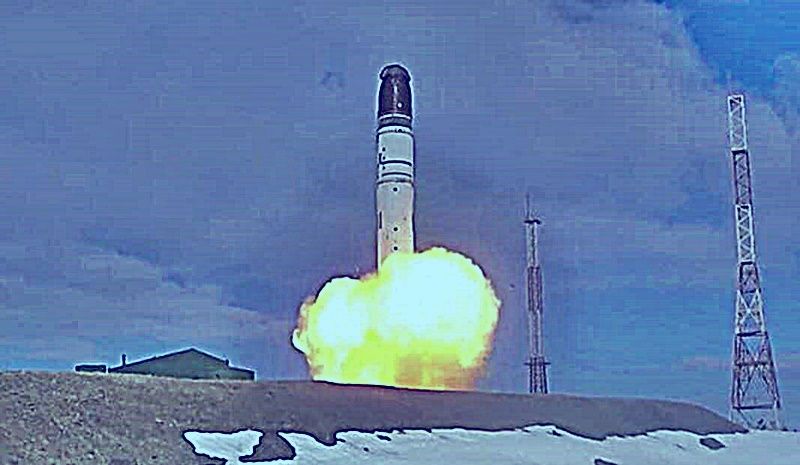Nuclear Nightmares in the Russia-US Weapons Challenge

By VT - Fabio G. C. Carisio -September 2, 2023
The Sarmat intercontinental ballistic missile, one of Russia’s most capable nuclear weapons, has been approved for active duty, Yury Borisov, the head of the Roscosmos space agency, has announced.
The development was revealed on Friday during a Roscosmos event. The weapon is believed to be the longest-range and heaviest missile in the Russian nuclear arsenal.
Russia’s longest-range Atomic Missile Sarmat into service. US to Send Depleted Uranium Ammo to Kyiv.
The liquid-fueled silo-based delivery vehicle, the final stage testing of which was completed last year, is the intended replacement for the aging R-36M2 Voevoda missiles. Its range is estimated at at least 11,000 miles (about 18,000km), with a payload weighing around 10 tons.
Russian President Vladimir Putin has touted the Sarmat’s range as offering new opportunities for defeating anti-ballistic missile systems. Shorter-range ICBMs can, for example, only reach the US from Russia by flying over the Arctic, and the US has ground-based interceptors situated for such a flight path.
Putin has repeatedly stressed that Russia was forced to develop the new weapon after the US reneged on its commitment not to build ABM systems. Russian Defense Minister Sergey Shoigu reported last December that deployment of the Sarmat had begun and that the missile would be ready for service in 2023.
Originally published by Russia Today
US to send depleted uranium munitions to Ukraine
The US is set to become the second country after the UK to greenlight shipments of depleted-uranium shells to Ukraine, according to Reuters, despite concerns that they could have a dramatic negative effect on public health and the environment.
The munitions are intended for US Abrams tanks, the first of which are expected to arrive in Ukraine in the coming weeks, the agency reported. According to several unnamed US officials and a document cited by Reuters on Saturday, the depleted uranium shells will be part of the next multi-million-dollar arms donation expected to be announced next week.
The reported plan follows another highly controversial US move to supply cluster munitions to Ukraine, which was criticized even by some of Washington’s closest allies. Should the White House approve depleted uranium shells for Ukraine, it would follow an earlier move by the UK, which announced similar shipments in March.
Read more: Ukraine to get US Abrams tanks within weeks – Politico
The UK’s decision caused outrage in Moscow, with Foreign Minister Sergey Lavrov saying the delivery would take “this escalation to a new and very serious stage.” Russia’s embassy in London accused the US and its allies of being willing to turn Ukraine into “not only an anti-Russian military shooting range, but also a radioactive landfill.”
When the toxic shells first showed up in Ukraine, Moscow warned that the UK would be “held accountable” for the irreparable harm caused to civilians and soldiers alike.
However, both UK and US officials have disputed the health hazards associated with DU shells – which use a dense uranium core to improve their armor-piercing capabilities – and dismissed studies indicating that the weapons are linked to a spike in cancer and birth defects in Iraq.
In the wake of the British move, Russian President Vladimir Putin announced that Moscow would respond by placing tactical nuclear weapons in neighboring Belarus. He noted that in this respect, Moscow’s actions do not differ from those of the US, which has stationed nuclear weapons in five European countries. Russia has said it would only remove the weapons if the US does the same with its own nuclear missiles in Europe and dismantles the infrastructure associated with them.
Ukraine’s Western backers claim that they are not directly participating in the conflict in Ukraine, and have avoided providing certain weapons – notably fighter jets and long-range missiles – that would risk provoking a direct clash with Russia. Nevertheless, they have sent Kyiv more than $100 billion in arms, while ignoring Moscow’s repeated warnings that every subsequent weapons package brings the US and NATO closer to active participation in the conflict.
Furthermore, by enabling Ukraine’s drone attacks on Russian civilians, Western nations have become “sponsors of terrorism,” according to the Kremlin.
Originally published by Russia Today

